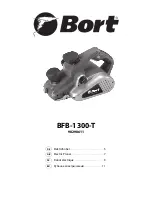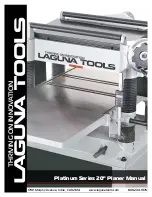
8
• If operating a power tool in a damp location is unavoid-
able, use a residual current device (RCD) protected sup-
ply. Use of an RCD reduces the risk of electric shock.
Personal safety
• Stay alert, watch what you are doing and use common
sense when operating a power tool. Do not use a power
tool while you are tired or under the infl uence of drugs,
alcohol or medication. A moment of inattention while
operating power tools may result in serious personal
injury.
• Use personal protective equipment. Always wear eye
protection. Protective equipment such as dust mask,
non-skid safety shoes, hard hat, or hearing protection
used for appropriate conditions will reduce personal
injuries.
• Prevent unintentional starting. Ensure the switch is in
the off -position before connecting to power source and/
or battery pack, picking up or carrying the tool. Carrying
power tools with your fi nger on the switch or energising
power tools that have the switch on invites accidents.
• Remove any adjusting key or wrench before turning the
power tool on. A wrench or a key left attached to a rotat-
ing part of the power tool may result in personal injury.
• Do not overreach. Keep proper footing and balance at
all times. This enables better control of the power tool in
unexpected situations.
• Dress properly. Do not wear loose clothing or jewellery.
Keep your hair, clothing and gloves away from mov-
ing parts. Loose clothes, jewellery or long hair can be
caught in moving parts.
• If devices are provided for the connection of dust extrac-
tion and collection facilities, ensure these are connected
and properly used. Use of dust collection can reduce
dust-related hazards.
Power tool use and care
• Do not force the power tool. Use the correct power
tool for your application. The correct power tool will
do the job better and safer at the rate for which it was
designed.
• Do not use the power tool if the switch does not turn
it on and off . Any power tool that cannot be controlled
with the switch is dangerous and must be repaired.
• Disconnect the plug from the power source and/or the
battery pack from the power tool before making any
adjustments, changing accessories, or storing power
tools. Such preventive safety measures reduce the risk of
starting the power tool accidentally.
• Store idle power tools out of the reach of children and
do not allow persons unfamiliar with the power tool
or these instructions to operate the power tool. Power
tools are dangerous in the hands of untrained users.
• Maintain power tools. Check for misalignment or bind-
ing of moving parts, breakage of parts and any other
condition that may aff ect the power tool’s operation.
If damaged, have the power tool repaired before use.
Many accidents are caused by poorly maintained power
tools.
• Keep cutting tools sharp and clean. Properly maintained
cutting tools with sharp cutting edges are less likely to
bind and are easier to control.
• Use the power tool, accessories and tool bits etc. in
accordance with these instructions, taking into account
the working conditions and the work to be performed.
Use of the power tool for operations diff erent from
those intended could result in a hazardous situation.
Service
Have your power tool serviced by a qualifi ed repair person
using only identical replacement parts. This will ensure
that the safety of the power tool is maintained.
PLANER SAFETY RULES
• Wait for the cutter to stop before setting the tool down.
An exposed rotating cutter may engage the surface
leading to possible loss of control and serious injury.
• Hold the power tool by insulated gripping surfaces only,
because the cutter may contact its own cord. Cutting a
“live” wire may make exposed metal parts of the power
tool “live” and could give the operator an electric shock.
• Use clamps or another practical way to secure and sup-
port the workpiece to a stable platform. Holding the
work by your hand or against the body leaves it unstable
and may lead to loss of control.
• Use suitable detectors to determine if utility lines are
hidden in the work area or call the local utility company
for assistance. Contact with electric lines can lead to
fi re and electric shock. Damaging a gas line can lead
to explosion. Penetrating a water line causes property
damage or may cause an electric shock.
• Do not reach into the saw dust ejector with your hands.
They could be injured by rotating parts.
• Apply the machine to the workpiece only when
switched on. Otherwise there is danger of kickback
when the cutting tool jams in the workpiece.
• When working, always hold the planer in such a manner
that the planer base plate faces fl at on the workpiece.
Otherwise the planer can become wedged and lead to
injuries.
• Never plane over metal objects, nails or screws. The
planer blade and the blade shaft can become damaged
and lead to increased vibrations.
MAINTENANCE AND CLEANING
Make sure that the machine is not live when carry-
ing out maintenance work on the motor.
• Regularly clean the machine housing with a soft cloth,
preferably after each use. Keep the ventilation slots free
from dust and dirt.If the dirt does not come off use a soft
cloth moistened with soapy water. Never use solvents
such as petrol, alcohol, ammonia water, etc. These sol-
vents may damage the plastic parts.
• The machine requires no additional lubrication.
• Should a fault occur, e.g. after wear of a part, please
contact your local BORT GLOBAL LIMITED dealer.
DISPOSAL
Discarded electric appliances are recyclable and
should not be discarded in the domestic waste!
Summary of Contents for 98298611
Page 1: ...BFB 1300 T 98298611 RU FR DE GB Elektrohobel 5 Electric Planer 7 Rabot lectrique 9 11...
Page 2: ...2 110 mm 0 7 mm 7 6 kg 1300 W 220 240 V 50 60 Hz 16000 min 1 0 3 5 mm max 60 80 100...
Page 3: ...3...
Page 4: ...4 7 1 2 3 4 5 6 7 8...
Page 18: ...18 RU FR DE GB Garantiebedingungen Warranty terms Conditions de garantie...









































